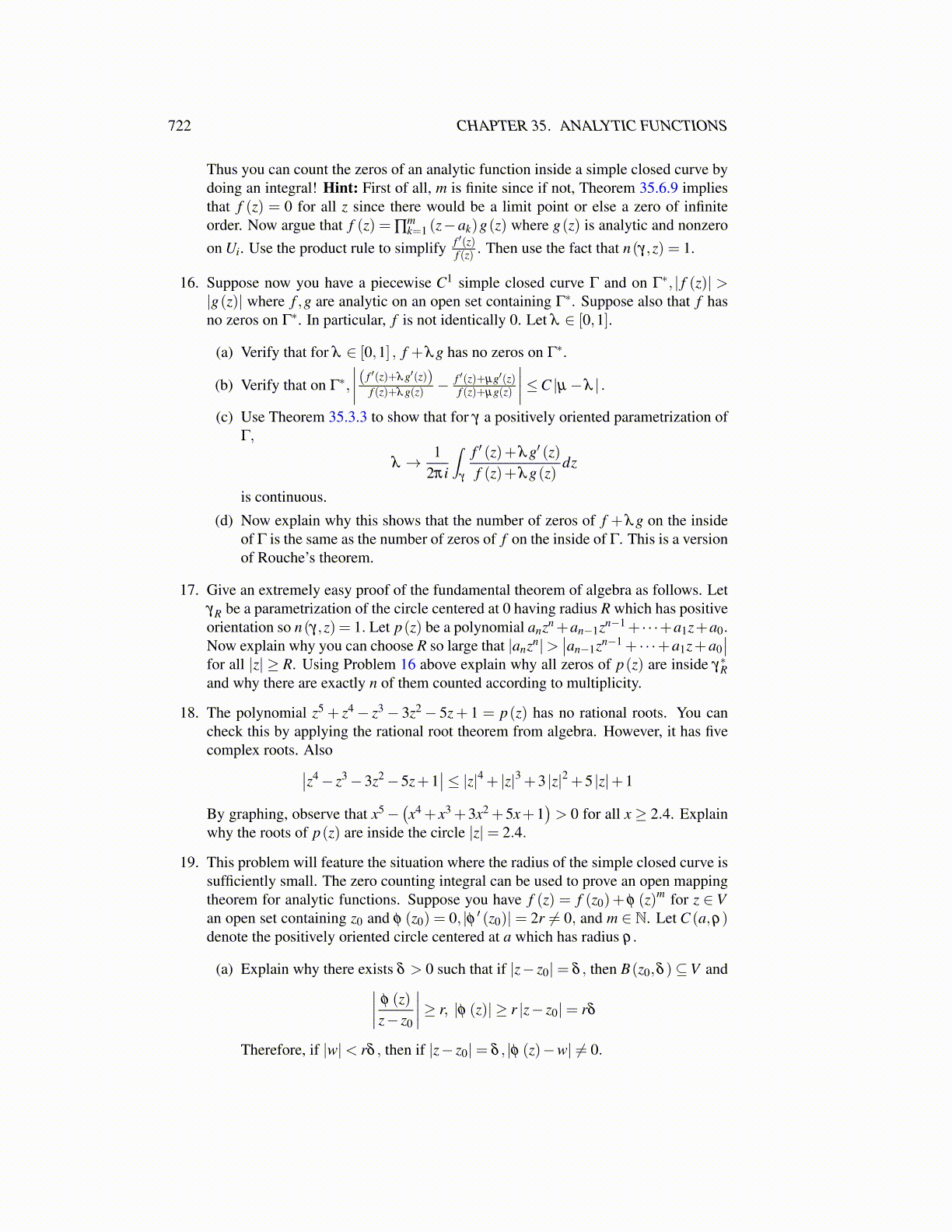
722 CHAPTER 35. ANALYTIC FUNCTIONS
Thus you can count the zeros of an analytic function inside a simple closed curve bydoing an integral! Hint: First of all, m is finite since if not, Theorem 35.6.9 impliesthat f (z) = 0 for all z since there would be a limit point or else a zero of infiniteorder. Now argue that f (z) = ∏
mk=1 (z−ak)g(z) where g(z) is analytic and nonzero
on Ui. Use the product rule to simplify f ′(z)f (z) . Then use the fact that n(γ,z) = 1.
16. Suppose now you have a piecewise C1 simple closed curve Γ and on Γ∗, | f (z)| >|g(z)| where f ,g are analytic on an open set containing Γ∗. Suppose also that f hasno zeros on Γ∗. In particular, f is not identically 0. Let λ ∈ [0,1].
(a) Verify that for λ ∈ [0,1] , f +λg has no zeros on Γ∗.
(b) Verify that on Γ∗,
∣∣∣∣ ( f ′(z)+λg′(z))f (z)+λg(z) −
f ′(z)+µg′(z)f (z)+µg(z)
∣∣∣∣≤C |µ−λ | .
(c) Use Theorem 35.3.3 to show that for γ a positively oriented parametrization ofΓ,
λ → 12πi
∫γ
f ′ (z)+λg′ (z)f (z)+λg(z)
dz
is continuous.
(d) Now explain why this shows that the number of zeros of f +λg on the insideof Γ is the same as the number of zeros of f on the inside of Γ. This is a versionof Rouche’s theorem.
17. Give an extremely easy proof of the fundamental theorem of algebra as follows. LetγR be a parametrization of the circle centered at 0 having radius R which has positiveorientation so n(γ,z) = 1. Let p(z) be a polynomial anzn+an−1zn−1+ · · ·+a1z+a0.Now explain why you can choose R so large that |anzn|>
∣∣an−1zn−1 + · · ·+a1z+a0∣∣
for all |z| ≥ R. Using Problem 16 above explain why all zeros of p(z) are inside γ∗Rand why there are exactly n of them counted according to multiplicity.
18. The polynomial z5 + z4− z3− 3z2− 5z+ 1 = p(z) has no rational roots. You cancheck this by applying the rational root theorem from algebra. However, it has fivecomplex roots. Also∣∣z4− z3−3z2−5z+1
∣∣≤ |z|4 + |z|3 +3 |z|2 +5 |z|+1
By graphing, observe that x5−(x4 + x3 +3x2 +5x+1
)> 0 for all x ≥ 2.4. Explain
why the roots of p(z) are inside the circle |z|= 2.4.
19. This problem will feature the situation where the radius of the simple closed curve issufficiently small. The zero counting integral can be used to prove an open mappingtheorem for analytic functions. Suppose you have f (z) = f (z0)+ φ (z)m for z ∈ Van open set containing z0 and φ (z0) = 0, |φ ′ (z0)|= 2r ̸= 0, and m ∈ N. Let C (a,ρ)denote the positively oriented circle centered at a which has radius ρ .
(a) Explain why there exists δ > 0 such that if |z− z0|= δ , then B(z0,δ )⊆V and∣∣∣∣ φ (z)z− z0
∣∣∣∣≥ r, |φ (z)| ≥ r |z− z0|= rδ
Therefore, if |w|< rδ , then if |z− z0|= δ , |φ (z)−w| ̸= 0.